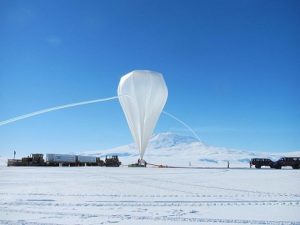
NASA’s super-pressure balloon finally took flight on April 25 from New Zealand’s Wanaka Airport, and now NASA scientists expect this balloon to break previous flight record and to stay in the air for up to 100 days. The football-stadium-sized, balloon carries with it a telescope that will be used by scientists at the University of Chicago and around the world to study cosmic rays.
The launch of this super pressure balloon launch was getting delayed for the past so many days due to the bad weather conditions.
NASA had announced flight readiness on March 25, but then three attempts to launch the balloon failed in April. The first attempt was done on April 8, second on April 9 and the third one on April 10. However, all the attempts failed due to uncertainty over balloon trajectory. On April 9, the team also experienced some mechanical issues with the launch vehicle crane.
On April 8, NASA postponed the launch from Wanaka Airport due to swirling winds in the stratosphere. The lift-off was scheduled to take place between 8 am and 11.30 am on Saturday, but the launch was postponed after NASA found a swirling wind eddy in the stratosphere, 33.5km above the earth’s surface, that could have made it difficult to predict the travel path of the balloon. According to NASA, the ground and lower-level winds were conducive for launch, but winds in the stratosphere were not. A swirling wind eddy had developed to the west of New Zealand’s North Island, and it would have made the travel path of the balloon unpredictable.
With this test flight, NASA wants to validate the balloon technology in so-called near-space. The first balloon from Wanaka Airport was launched two years back in 2015, and it successfully completed 32 days of flight. In 2016, the NASA’s balloon was able to achieve 46 days of flight. This time, NASA wants the balloon to stay up for up to 100 days, thus break the current record of 54 days for such balloons.
This balloon is made from polyethylene film, and is durable and stronger. When fully inflated it achieves the size of Forsyth-Barr Stadium in Dunedin. A special launch pad has also been constructed for this balloon.
This project is named Extreme Universe Space Observatory on a Super Pressure Balloon (EUSO-SPB), and is “searching for the most energetic cosmic particles ever observed,” according to Angela V. Olinto, the Homer J. Livingston Distinguished Service Professor at the University of Chicago and principal investigator of the project.
